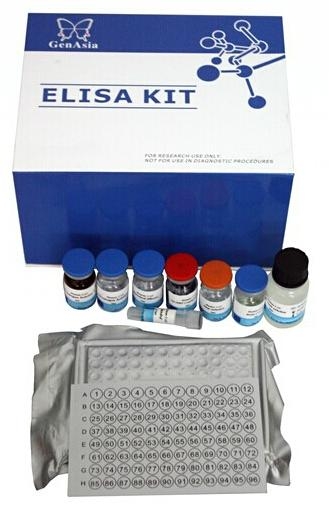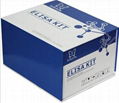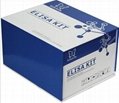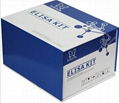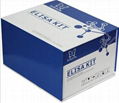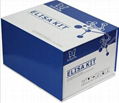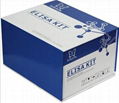| Model: | - |
|---|---|
| Brand: | Genasia |
| Origin: | Made In China |
| Category: | Chemicals / Chemical Reagent |
| Label: | elisa , elisa kits , INS |
| Price: |
US $360
/ pc
|
| Min. Order: | 1 pc |
Product Description
Human Insulin (INS) ELISA Kit
[Instruction]
[Sample Types Validated]

FOR RESEARCH USE ONLY. NOT FOR USE IN DIAGNOSTIC PROCEDURES.

|
【Catalogue No.】 |
|
GA-E0001HM |
|
【Application】 |
This kit is used to assay the Insulin(INS) in the sample of Human serum, blood plasma and other related biological liquid.
|
【Principle】 |
||||||||||||||||||||||||||||||||||||||||||||||||||||
|
This kit uses enzyme-linked immune sorbent assay (ELISA) based on biotin double antibody sandwich technology to assay Human Insulin(INS). Add Insulin(INS) to wells that are pre-coated with Insulin(INS) monoclonal antibody and then incubate. After incubation, add anti Insulin(INS) antibodies labeled with biotin to unite with Streptavidin-HRP, which forms the immune complex. Remove unbound enzymes after incubation and washing, then add substrate A and B. The solution will turn blue and change to yellow with the effect of acid. The shades of solution and the concentration of Human Insulin(INS) are positively correlated. |
||||||||||||||||||||||||||||||||||||||||||||||||||||
|
【Materials Supplied in the Test Kit】 |
||||||||||||||||||||||||||||||||||||||||||||||||||||
|
||||||||||||||||||||||||||||||||||||||||||||||||||||
|
|
||||||||||||||||||||||||||||||||||||||||||||||||||||
|
【Materials Required but Not Provided】 |
||||||||||||||||||||||||||||||||||||||||||||||||||||
|
① 37℃ incubator ② Standard ELISA reader ③ Precision pipettes and disposable pipette tips ④ Distilled water ⑤ Disposable tubes ⑥ Absorbent paper |
||||||||||||||||||||||||||||||||||||||||||||||||||||
|
【Important Notes】 |
||||||||||||||||||||||||||||||||||||||||||||||||||||
|
a) Hold kit at room temperature for at least 30 minutes once removed from 2-8℃ environment. Coated ELISA plates should be stored in sealed bag if not used after opening. b) When adding samples, sample injector must be used each time and should also be frequently checked for precision to avoid individual error. c) The operating instructions must be strictly followed and the reading of ELISA reader must be set as the standard for determining the experiment result. d) Pipette tips and seal plate membrane in hand should not be used more than once in order to avoid cross contamination. e) All samples, washing concentration, and all waste should be disposed as infective agents. f) Other reagents not needed shall be packed or covered. Reagents of different batches shall not be mixed and should be used before their respective validity dates. g) Substrate B is sensitive to light and therefore should not be over-exposed to light. |
||||||||||||||||||||||||||||||||||||||||||||||||||||
|
【Washing Method】 |
||||||||||||||||||||||||||||||||||||||||||||||||||||
|
a) Washing by Hand: Shake off liquids in the wells of the ELISA plate. Lay several bibulous papers on the test bed and pat the ELISA plate hard several times downward. Then inject at least 0.35ml of diluted washing concentrate and soak for 1-2 minutes. Repeat as needed. b) Washing by Automatic Plate Washer: If an automatic plate washer is available, it should only be used in the test by those proficient with its function. |
||||||||||||||||||||||||||||||||||||||||||||||||||||
|
【Specimen Requirements】 |
||||||||||||||||||||||||||||||||||||||||||||||||||||
|
a) Samples containing NaN3 shall not be tested as they inhibit the activity of Horse Radish Peroxidase (HRP). b) Upon sample collection, extraction should be carried out as soon as possible in accordance with related documents. After extraction, the experiment should be conducted immediately as well. Otherwise, the sample should be preserved at -20℃. Repeated freeze-thaw cycles should be avoided. c) Serum: Allow the serum to clot for 10-20 minutes at room temperature, then place in centrifuge (at 2000-3000 RPM) for approximately 20 minutes. Collect the supernatants carefully. If sediments have occurred during storage, centrifugation should be repeated. d) Blood Plasma: In accordance with sample collection requirements, EDTA or sodium citrate should be used for anticoagulation. Add EDTA or sodium citrate and mix them for 10-20 minutes, then place in centrifuge(at 2000-3000 RPM) for approximately 20 minutes. Collect supernatants carefully. If sediments have occurred during storage, centrifugation should be repeated. e) Urine: Collect with sterile tube. Place in centrifuge (at 2000-3000 RPM) for approximately 20 minutes. Collect the supernatants carefully. If sediments have occurred during storage, centrifugation should be repeated. When collecting pleuroperitoneal fluid and cerebrospinal fluid, please follow the procedures mentioned above. f) Cell Culture Supernatant: Collect with sterile tubes when examining secrete components. Place in centrifuge (at 2000-3000 RPM) for approximately 20 minutes. Collect the supernatants carefully. When examining the components within the cell, use PBS (PH 7.2-7.4) to dilute cell suspension to cell concentration of approximately 1 million/ml. Degrade cells through repeated freeze-thaw cycles to release interior components. Place in centrifuge (at 2000-3000 RPM) for approximately 20 minutes. Collect the supernatants carefully. If sediments have occurred during storage, centrifugation should be repeated. g) Tissue Sample: Incise sample and weigh. Add a given amount of PBS (PH 7.4). Immediately freeze with liquid nitrogen for later use. Thaw sample and hold at 2-8℃. Add a given amount of PBS (PH 7.4), then homogenize the sample thoroughly by hand or with homogenizer. Place in centrifuge (at 2000-3000 RPM) for approximately 20 minutes. Collect the supernatants carefully. Aliquot and keep one for examination and freeze the others for later use. |
||||||||||||||||||||||||||||||||||||||||||||||||||||
|
【Assay Procedure】 |
||||||||||||||||||||||||||||||||||||||||||||||||||||
|
a) Dilution of standard solutions: (This kit provides one standard original concentration. Users may independently dilute in small tubes following the chart below.)
b) The number of stripes needed is determined by that of samples to be tested added by the standards. It is recommended that each standard solution and each blank well be arranged with multiple wells as much as possible. c) Sample injection: 1) Blank well: no sample, anti INS antibody labeled with biotin or Streptavidin-HRP is added to comparison blank well; add chromogen solution A & B and stop solution, each other step operation is the same. 2) Standard solution well: Add 50μl standard and streptomycin-HRP 50μl (biotin antibodies have united in advance in the standard so no biotin antibodies are added). 3) Sample well to be tested: Add 40μl sample and then 10μl INS antibodies, 50μl Streptavidin-HRP. Then cover it with seal plate membrane. Shake gently to mix. Incubate at 37℃ for 60 minutes. d) Preparation of washing solution: Dilute the washing concentration (30X) with distilled water for later use. e) Washing: carefully remove the seal plate membrane, drain liquid and shake off the remainder. Fill each well with washing solution, let stand for 30 seconds, then drain. Repeat this procedure five times then blot the plate. f) Color development: First add 50μl chromogen solution A to each well, and then add 50μl chromogen solution B to each well. Shake gently to mix. Incubate for 10 minutes at 37℃ away from light for color development. g) Stop: Add 50μl Stop Solution to each well to stop the reaction (color changes from blue to yellow immediately at that moment). h) Assay: Take blank well as zero, measure the absorbance (OD) of each well one by one under 450nm wavelength, which should be conducted within10 minutes after having added stop solution. i) According to standards concentrations and corresponding OD values, calculate the linear regression equation of the standard curve. Then according to the OD value of samples, calculate the concentration of the corresponding sample. Statistical software could also be employed. |
||||||||||||||||||||||||||||||||||||||||||||||||||||
|
【Summary】 |
||||||||||||||||||||||||||||||||||||||||||||||||||||
|
|
|
【Calculation】 |
|
|
|
【Assay range and Sensitivity】 |
|
Assay range:0.5ng/L→200ng/L Sensitivity:0.248ng/L (The sensitivity of this assay was defined as the lowest protein concentration that could be differentiated from zero. It was determined by sub-tracing two standard deviations to the mean optical density value of twenty zero standard replicates and calculating the corresponding concentration.) |
|
【Specificity】 |
|
This assay has high sensitivity and excellent specificity for detection of Human INS. No significant cross-reactivity or interference between Human INS and analogues was observed. Note: Limited by current skills and knowledge, it is impossible for us to complete the cross- reactivity detection between Human INS and all the analogues, therefore, cross reaction may still exist. |
|
【Precision】 |
|
Intra-assay Precision (Precision within an assay): 3 samples with low, middle and high level Human INS were tested 20 times on one plate, respectively. Inter-assay Precision (Precision between assays): 3 samples with low, middle and high level Human INS were tested on 3 different plates, 8 replicates in each plate. CV(%) = SD/meanX100 Intra-Assay: CV<10% Inter-Assay: CV<12% |
|
【Package size】 |
|
96T Per Kit. |
|
【Validity &Storage】 |
|
Six Months(2-8℃) |
Member Information
| Genasia Biology (Shang Hai) Limited | |
|---|---|
| Country/Region: | Shang Hai - China |
| Business Nature: | Manufacturer |
| Phone: | 56642915 |
| Contact: | kim (operations) |
| Last Online: | 08 Aug, 2015 |
Related Products of this Company
-
Human Tri-iodothyronine(T3) ELISA Kit
US $360
-
Human Orientia Tsutsugamushi(IgG)ELISA
US $360
-
Sheep Immunoglobulin M(IgM) ELISA Kit
US $460
-
Human Prorenin Soluble receptor(RR)
US $360
-
Plant Abscisic acid(ABA)ELISA Kit
US $460
-
Human Apolipoprotein E(Apo-E) ELISA Kit
US $360
-
Human dynein cytoplasmic 2 heavy
US $360
-
Mouse Anti-nuclear Antibody(ANA) ELISA
US $460
-
Human Orientia Tsutsugamushi(IgM)ELISA
US $360
-
Human remnant lipoprotein
US $360





